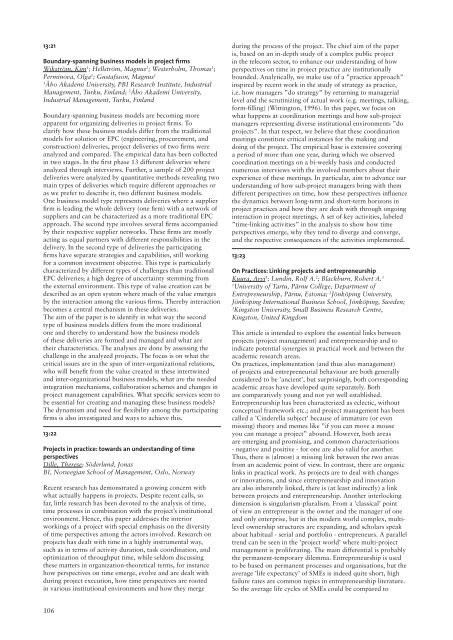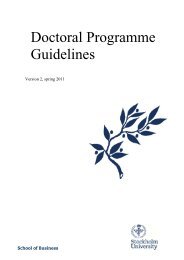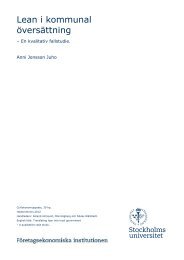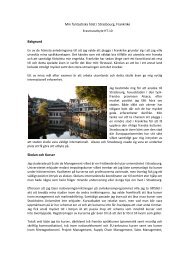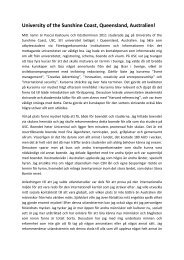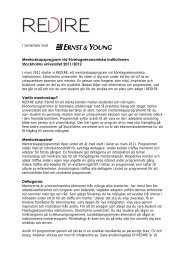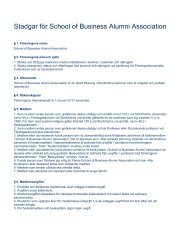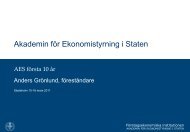Download full programme and abstract book pdf 1.6
Download full programme and abstract book pdf 1.6
Download full programme and abstract book pdf 1.6
You also want an ePaper? Increase the reach of your titles
YUMPU automatically turns print PDFs into web optimized ePapers that Google loves.
13:21<br />
Boundary-spanning business models in project firms<br />
Wikström, Kim 1 ; Hellström, Magnus 2 ; Westerholm, Thomas 1 ;<br />
Perminova, Olga 1 ; Gustafsson, Magnus 1<br />
1 Åbo Akademi University, PBI Research Institute, Industrial<br />
Management, Turku, Finl<strong>and</strong>; 2 Åbo Akademi University,<br />
Industrial Management, Turku, Finl<strong>and</strong><br />
Boundary-spanning business models are becoming more<br />
apparent for organizing deliveries in project firms. To<br />
clarify how these business models differ from the traditional<br />
models for solution or EPC (engineering, procurement, <strong>and</strong><br />
construction) deliveries, project deliveries of two firms were<br />
analyzed <strong>and</strong> compared. The empirical data has been collected<br />
in two stages. In the first phase 13 different deliveries where<br />
analyzed through interviews. Further, a sample of 200 project<br />
deliveries were analyzed by quantitative methods revealing two<br />
main types of deliveries which require different approaches or<br />
as we prefer to describe it, two different business models.<br />
One business model type represents deliveries where a supplier<br />
firm is leading the whole delivery (one firm) with a network of<br />
suppliers <strong>and</strong> can be characterized as a more traditional EPC<br />
approach. The second type involves several firms accompanied<br />
by their respective supplier networks. These firms are mostly<br />
acting as equal partners with different responsibilities in the<br />
delivery. In the second type of deliveries the participating<br />
firms have separate strategies <strong>and</strong> capabilities, still working<br />
for a common investment objective. This type is particularly<br />
characterized by different types of challenges than traditional<br />
EPC deliveries; a high degree of uncertainty stemming from<br />
the external environment. This type of value creation can be<br />
described as an open system where much of the value emerges<br />
by the interaction among the various firms. Thereby interaction<br />
becomes a central mechanism in these deliveries.<br />
The aim of the paper is to identify in what way the second<br />
type of business models differs from the more traditional<br />
one <strong>and</strong> thereby to underst<strong>and</strong> how the business models<br />
of these deliveries are formed <strong>and</strong> managed <strong>and</strong> what are<br />
their characteristics. The analyses are done by assessing the<br />
challenge in the analyzed projects. The focus is on what the<br />
critical issues are in the span of inter-organizational relations,<br />
who will benefit from the value created in these intertwined<br />
<strong>and</strong> inter-organizational business models, what are the needed<br />
integration mechanisms, collaboration schemes <strong>and</strong> changes in<br />
project management capabilities. What specific services seem to<br />
be essential for creating <strong>and</strong> managing these business models?<br />
The dynamism <strong>and</strong> need for flexibility among the participating<br />
firms is also investigated <strong>and</strong> ways to achieve this.<br />
13:22<br />
Projects in practice: towards an underst<strong>and</strong>ing of time<br />
perspectives<br />
Dille, Therese; Söderlund, Jonas<br />
BI, Norwegian School of Management, Oslo, Norway<br />
Recent research has demonstrated a growing concern with<br />
what actually happens in projects. Despite recent calls, so<br />
far, little research has been devoted to the analysis of time,<br />
time processes in combination with the project’s institutional<br />
environment. Hence, this paper addresses the interior<br />
workings of a project with special emphasis on the diversity<br />
of time perspectives among the actors involved. Research on<br />
projects has dealt with time in a highly instrumental way,<br />
such as in terms of activity duration, task coordination, <strong>and</strong><br />
optimization of throughput time, while seldom discussing<br />
these matters in organization-theoretical terms, for instance<br />
how perspectives on time emerge, evolve <strong>and</strong> are dealt with<br />
during project execution, how time perspectives are rooted<br />
in various institutional environments <strong>and</strong> how they merge<br />
106<br />
during the process of the project. The chief aim of the paper<br />
is, based on an in-depth study of a complex public project<br />
in the telecom sector, to enhance our underst<strong>and</strong>ing of how<br />
perspectives on time in project practice are institutionally<br />
bounded. Analytically, we make use of a ”practice approach”<br />
inspired by recent work in the study of strategy as practice,<br />
i.e. how managers ”do strategy” by returning to managerial<br />
level <strong>and</strong> the scrutinizing of actual work (e.g. meetings, talking,<br />
form-filling) (Wittington, 1996). In this paper, we focus on<br />
what happens at coordination meetings <strong>and</strong> how sub-project<br />
managers representing diverse institutional environments ”do<br />
projects”. In that respect, we believe that these coordination<br />
meetings constitute critical instances for the making <strong>and</strong><br />
doing of the project. The empirical base is extensive covering<br />
a period of more than one year, during which we observed<br />
coordination meetings on a bi-weekly basis <strong>and</strong> conducted<br />
numerous interviews with the involved members about their<br />
experience of these meetings. In particular, aim to advance our<br />
underst<strong>and</strong>ing of how sub-project managers bring with them<br />
different perspectives on time, how these perspectives influence<br />
the dynamics between long-term <strong>and</strong> short-term horizons in<br />
project practices <strong>and</strong> how they are dealt with through ongoing<br />
interaction in project meetings. A set of key activities, labeled<br />
”time-linking activities” in the analysis to show how time<br />
perspectives emerge, why they tend to diverge <strong>and</strong> converge,<br />
<strong>and</strong> the respective consequences of the activities implemented.<br />
13:23<br />
On Practices: Linking projects <strong>and</strong> entrepreneurship<br />
Kuura, Arvi 1 ; Lundin, Rolf A. 2 ; Blackburn, Robert A. 3<br />
1 University of Tartu, Pärnu College, Department of<br />
Entrepreneurship, Pärnu, Estonia; 2 Jönköping University,<br />
Jönköping International Business School, Jönköping, Sweden;<br />
3 Kingston University, Small Business Research Centre,<br />
Kingston, United Kingdom<br />
This article is intended to explore the essential links between<br />
projects (project management) <strong>and</strong> entrepreneurship <strong>and</strong> to<br />
indicate potential synergies in practical work <strong>and</strong> between the<br />
academic research areas.<br />
On practices, implementation (<strong>and</strong> thus also management)<br />
of projects <strong>and</strong> entrepreneurial behaviour are both generally<br />
considered to be ’ancient’, but surprisingly, both corresponding<br />
academic areas have developed quite separately. Both<br />
are comparatively young <strong>and</strong> not yet well established.<br />
Entrepreneurship has been characterized as eclectic, without<br />
conceptual framework etc.; <strong>and</strong> project management has been<br />
called a ’Cinderella subject’ because of immature (or even<br />
missing) theory <strong>and</strong> memes like ”if you can move a mouse<br />
you can manage a project” abound. However, both areas<br />
are emerging <strong>and</strong> promising, <strong>and</strong> common characterisations<br />
- negative <strong>and</strong> positive - for one are also valid for another.<br />
Thus, there is (almost) a missing link between the two areas<br />
from an academic point of view. In contrast, there are organic<br />
links in practical work. As projects are to deal with changes<br />
or innovations, <strong>and</strong> since entrepreneurship <strong>and</strong> innovation<br />
are also inherently linked, there is (at least indirectly) a link<br />
between projects <strong>and</strong> entrepreneurship. Another interlocking<br />
dimension is singularism-pluralism. From a ’classical’ point<br />
of view an entrepreneur is the owner <strong>and</strong> the manager of one<br />
<strong>and</strong> only enterprise, but in this modern world complex, multilevel<br />
ownership structures are exp<strong>and</strong>ing, <strong>and</strong> scholars speak<br />
about habitual - serial <strong>and</strong> portfolio - entrepreneurs. A parallel<br />
trend can be seen in the ’project world’ where multi-project<br />
management is proliferating. The main differential is probably<br />
the permanent-temporary dilemma. Entrepreneurship is used<br />
to be based on permanent processes <strong>and</strong> organisations, but the<br />
average ’life expectancy’ of SMEs is indeed quite short, high<br />
failure rates are common topics in entrepreneurship literature.<br />
So the average life cycles of SMEs could be compared to


